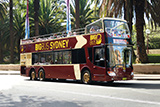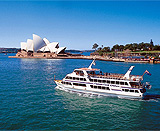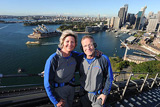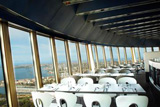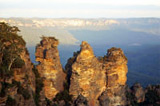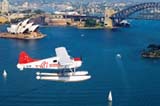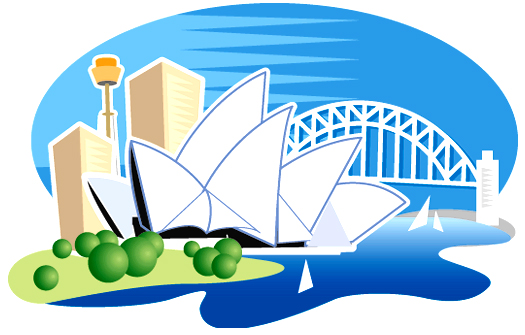
sydney.com.au
Est 1994, Sydney's oldest tourism website


SYDNEY RESOURCES
Driving in Sydney and around Australia
Most Australians are aware of what it is like to drive in Sydney and other capital cities, so this web page is written entirely with the international visitor in mind.
In Australia, cars are right-hand-drive and people drive on the left of the road. Unlike the United States, where driving is relatively easy and a real buzz because of the vast number of freeways that skirt around cities, much of the driving in Australia - both inside and outside capital cities - is on dual-carriage roads where you are constantly faced with fast, oncoming traffic.
Away from the cities, Australian freeways and motorways have evolved to a good standard but are not a match for Germany's autobahms or other European motorways.
In Sydney, where harbour suburbs dictate the haphazard direction of roads, traffic congestion and the fast flow of traffic makes driving quite hectic for residents, let alone visitors.
If you are visiting Sydney you are far better to use the excellent public transport system, which is much faster and relatively stress-free.
If you need to drive, make sure you hire a car with a GPS navigation device (or at least have a smart phone with maps) because trying to find your way around Sydney with a paper map is difficult.
GPS systems in cars will also help if you're not used to driving on the left-hand side of the road.
International driving licences
International visitors may drive in Australia on a valid overseas driver's licence that covers the same vehicle class in their own country.
While driving, make sure you carry your licence with you as well as the international driving licence. You are permitted to drive for three months on an international driving licence.
The onus is on international visitors who plan to drive in Australia to have some understanding of the road rules before arriving here. One way to gain a general understanding of Australian road rules is by completing this tourist-focused quiz.
Fuel
Petrol is sold in litres and comes in both unleaded and lead substitute forms. Prices will vary depending upon location and in the major cities you will see price fluctuations during any given week and national holidays. In Sydney, petrol was about $1.12 a litre mid way through january 2016. One year earlier, it was as high as $1.58 a litre.
Petrol stations are everywhere so you don't need to worry about where to fill up.
Check here for prices in and around Sydney.
Insurance
If you plan to hire a car, be careful with insurance. Car rental companies often have varying forms of insurance cover. Always insist on insurance that will cover you completely in the event of an accident - regardless of whether you are in the right or wrong.
In Australia, police do not attend traffic accidents unless someone is injured. As a result of this practice, a "no fault" policy has evolved among insurance companies, which means you'll most likely end up having to pay an "excess" if you have an accident. You usually have the option to pay more to reduce the amount of the "excess".
If you plan to go "off road" where there are unsealed, gravel roads and overhanging tree branches, take care because poor roads can easily be the cause of accidents (eg stone marks, scraped roofs, bogged vehicles, smashed windscreens and collisions with wildlife). The roads in country areas of Australia are completely different to those of Europe, Great Britain, US, Singapore and Hong Kong and less forgiving to the unwary motorist.
Speed Limits
In the Sydney CBD, the speed limit is 40km/h. In other parts of Sydney, where road speeds are not posted, the default speed limit is 50km/h.
Special speed limits apply in school and hospital zones and these are clearly posted.
If you're travelling outside Sydney, the maximum speed on rural roads is 100km/h and the maximum speed on motorways and freeways is 110km/h. This pattern generally follows in most Australian states.
All states throughout Australia operate sophisticated speed detection equipment including mobile and static speed cameras, and traffic-light cameras. Police also sit beside freeways with the intent to catch speeding motorists. Any fine incurred in Australia is the responsibility of the driver and should they be a foreign national the fine will be mailed to their home country address.
Safety belts and child cestraints
Wearing a seat belt in Australia has been compulsory since 1962. This applies to both front and rear seated vehicle occupants. You are also required to wear a seatbelt if you are riding in a taxis otherwise both you and the driver will be fined. (Drivers are liable in the event that a passenger fails to belt up).
Child restraints are compulsory for children to age seven. If you have small children, make sure your vehicle is fitted with child restraints when hiring a vehicle.
Drink Driving
All Australian states enforce strict drink drinking laws and the police are entitled to stop drivers on a random basis for breathalyser tests. These operations are often referred to as a "Random Breath Test" or "RBT". In most states the legal limit is 0.05.
Driving outside cities
The distances in Australia are vast compared to those in Europe, the United Kingdom, Singapore and Hong Kong. To drive from Sydney to Melbourne on a four-lane freeway will take you the best part of 10 hours, including rest breaks.
Police advise drivers to take lots of breaks as driver fatigue is the cause of many fatal accidents. People should avoid driving on country roads at night as wildlife - kangaroos, wallabies and wombats - graze beside the road and have poor road sense and are attracted to car lights. They cansuddenly appear on roads without any warning. Apart from the native wildlife being killed, drivers can be killed or seriously injured and cars badly damaged.
Driving in the Outback
If you plan to travel by car throughout Australia it should be mentioned that driving in the outback is unlike driving anywhere else in Australia. The outback comprises vast distances of arid land without water, and few roadhouse stops. It can be ferociously hot during the day and bitterly cold at night. On some roads you may not see another vehicle for long periods of time.
The most important thing to remember should you decide to go "off road" (off a sealed road) in the Outback is to seek local advice on your intended route, as well as ensuring someone local knows of your travel plans. If your vehicle does break down in a remote area, stay with it and do not attempt to walk. Generally people who stay with their vehicles are located quickly and easily.
Note that most rental providers have conditions that restrict or limit the use of vehicles in the Outback. Should you plan to go off-road you should discuss your intended route with the rental company beforehand.
I
t is a legal requirement that any gates opened on properties to allow your vehicle to pass through are closed afterwards. These gates contain livestock.
Any travel across designated Aboriginal Land will require permission from the owners beforehand. As the permit process varies from state to state (and can take up to six weeks to obtain), it is best to contact the national parks' controlling body in each state prior to your journey.
Road Trains
A common sight in the Outback, particularly on highways in Northern Territory, Queensland, South Australia and Western Australia, are road trains. These are multi-trailer trucks that can be up to 53.5m long (176 ft). Always allow plenty of room as you pass in the opposite direction of a road train as the displaced air causes severe buffeting. When overtaking a road train allow, 1.5 kilometres (0.8 miles) of clear road ahead.
Outback Road Conditions
Australia has an extreme of climates especially in the north. Minor roads that are passable in the Dry season (March - November) can disappear beneath a torrent of water during the "Wet". Seek local advice should your travels take you off the main highways.
Some things to look out for in country areas include potholes and rough surfaces, soft road edges and road surfaces changing without notice.
A golden rule of travelling in the outback is to leave an iternary with someone reliable locally (e.g. police) with an estimated travel time for your journey. Take plenty of water with you and be aware that you will not have mobile phone coverage for much of the time.
If your car should break down, stay with the car - do not walk away from it in search of help because the likelihood is that help may be hunderds of kilometres away.
